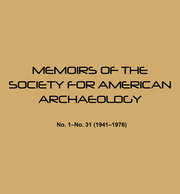No CrossRef data available.
Article contents
Notes on Chipped Points and Classification Systems
Published online by Cambridge University Press: 27 June 2018
Extract
Chipped stone points are now classified according to a scheme suggested by Thomas Wilson in 1898, worked out by Gifford and Schenck in 1926, and carefully modified by Strong in 1935. Part of Strong's modification developed from his earlier work in the Dalles-Deschutes region. The classification is based upon analysis of form. The presence or absence of a stem, indicated by S- and N- respectively, is used as the primary basis for division with the shape of the stem secondary. In discussing the Dalles-Deschutes points, Strong, Schenck, and Steward question the validity of the particular elements selected: “There remains some question whether the shape of the stem … or the presence of a shoulder or barb … should be chosen for secondary classification. We endeavor to present data so that either may be used.”
- Type
- Research Article
- Information
- Copyright
- Copyright © Society for American Archaeology 1950
References
1 Strong, Schenck, and Steward, 1930, p. 80.
2 Collier, Hudson, and Ford, 1942, Pl. I, L.
3 Ibid., Table 3, p. 62.
4 Point classification for King's excavations in the San Juan Islands was not available when this was written (King, 19S0).
5 Collier, Hudson, and Ford, 1942, Table 3, p. 62.
6 Strong, Schenck, and Steward, 1930, p. 76.
7 H. I. Smith, 1910, Pl. II.
8 H. I. Smith, 19006, p. 136.
9 Hill-Tout, 1938.
10 Gifford and Schenck, 1926, p. 85.
11 Schenck, 1926, Pl. 48, g.
12 Ibid., Pl. 48, h and k.
13 Loud, 1918, p. 393.
14 Leatherman and Krieger, 1040, Fig. 29.
15 I piutak and the Arctic Whale Hunting Culture (Larsen and Rainey, 1948) appeared after this paper was written. Its plates and figures show striking similarities to some Columbia-Fraser finds, especially in the McClallum Middle Fraser Collection, and its descriptions of chipped stone artifacts would have gone far to supply the classification system needed to clarify our materials.


